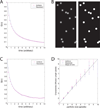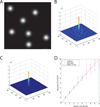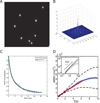Image correlation microscopy for uniform illumination
- PMID: 20055917
- PMCID: PMC3147011
- DOI: 10.1111/j.1365-2818.2009.03300.x
Image correlation microscopy for uniform illumination
Abstract
Image cross-correlation microscopy is a technique that quantifies the motion of fluorescent features in an image by measuring the temporal autocorrelation function decay in a time-lapse image sequence. Image cross-correlation microscopy has traditionally employed laser-scanning microscopes because the technique emerged as an extension of laser-based fluorescence correlation spectroscopy. In this work, we show that image correlation can also be used to measure fluorescence dynamics in uniform illumination or wide-field imaging systems and we call our new approach uniform illumination image correlation microscopy. Wide-field microscopy is not only a simpler, less expensive imaging modality, but it offers the capability of greater temporal resolution over laser-scanning systems. In traditional laser-scanning image cross-correlation microscopy, lateral mobility is calculated from the temporal de-correlation of an image, where the characteristic length is the illuminating laser beam width. In wide-field microscopy, the diffusion length is defined by the feature size using the spatial autocorrelation function. Correlation function decay in time occurs as an object diffuses from its original position. We show that theoretical and simulated comparisons between Gaussian and uniform features indicate the temporal autocorrelation function depends strongly on particle size and not particle shape. In this report, we establish the relationships between the spatial autocorrelation function feature size, temporal autocorrelation function characteristic time and the diffusion coefficient for uniform illumination image correlation microscopy using analytical, Monte Carlo and experimental validation with particle tracking algorithms. Additionally, we demonstrate uniform illumination image correlation microscopy analysis of adhesion molecule domain aggregation and diffusion on the surface of human neutrophils.
Figures






Similar articles
-
Resolving Fast, Confined Diffusion in Bacteria with Image Correlation Spectroscopy.Biophys J. 2016 May 24;110(10):2241-51. doi: 10.1016/j.bpj.2016.04.023. Biophys J. 2016. PMID: 27224489 Free PMC article.
-
Wide-field fluorescence sectioning with hybrid speckle and uniform-illumination microscopy.Opt Lett. 2008 Aug 15;33(16):1819-21. doi: 10.1364/ol.33.001819. Opt Lett. 2008. PMID: 18709098
-
Measuring fast dynamics in solutions and cells with a laser scanning microscope.Biophys J. 2005 Aug;89(2):1317-27. doi: 10.1529/biophysj.105.062836. Epub 2005 May 20. Biophys J. 2005. PMID: 15908582 Free PMC article.
-
Recent advancements in structured-illumination microscopy toward live-cell imaging.Microscopy (Oxf). 2015 Aug;64(4):237-49. doi: 10.1093/jmicro/dfv034. Epub 2015 Jun 30. Microscopy (Oxf). 2015. PMID: 26133185 Review.
-
Advances in image correlation spectroscopy: measuring number densities, aggregation states, and dynamics of fluorescently labeled macromolecules in cells.Cell Biochem Biophys. 2007;49(3):141-64. doi: 10.1007/s12013-007-9000-5. Epub 2007 Oct 2. Cell Biochem Biophys. 2007. PMID: 17952641 Review.
Cited by
-
Use of TIRF to Monitor T-Lymphocyte Membrane Dynamics with Submicrometer and Subsecond Resolution.Cell Mol Bioeng. 2015;8(1):178-186. doi: 10.1007/s12195-014-0361-8. Epub 2014 Oct 22. Cell Mol Bioeng. 2015. PMID: 25798205 Free PMC article.
-
Impact of uniform illumination in widefield microscopy and mesoscopy.Sci Rep. 2025 Jul 14;15(1):25400. doi: 10.1038/s41598-025-08754-0. Sci Rep. 2025. PMID: 40659689 Free PMC article.
-
Nuclear herpesvirus capsid motility is not dependent on F-actin.mBio. 2014 Oct 7;5(5):e01909-14. doi: 10.1128/mBio.01909-14. mBio. 2014. PMID: 25293761 Free PMC article.
-
Dynamics of adhesion molecule domains on neutrophil membranes: surfing the dynamic cell topography.Eur Biophys J. 2013 Dec;42(11-12):851-5. doi: 10.1007/s00249-013-0931-z. Epub 2013 Oct 10. Eur Biophys J. 2013. PMID: 24113789 Free PMC article.
References
-
- Bates IR, Wiseman PW, Hanrahan JW. Investigating membrane protein dynamics in living cells. Biochem Cell Biol. 2006;84:825–831. - PubMed
-
- Cairo CW, Mirchev R, Golan DE. Cytoskeletal regulation couples LFA-1 conformational changes to receptor lateral mobility and clustering. Immunity. 2006;25:297–308. - PubMed
-
- Ehrenberg M, McGrath JL. Binding between particles and proteins in extracts: implications for microrheology and toxicity. Acta Biomater. 2005;1:305–315. - PubMed
MeSH terms
Substances
Grants and funding
LinkOut - more resources
Full Text Sources
Miscellaneous

